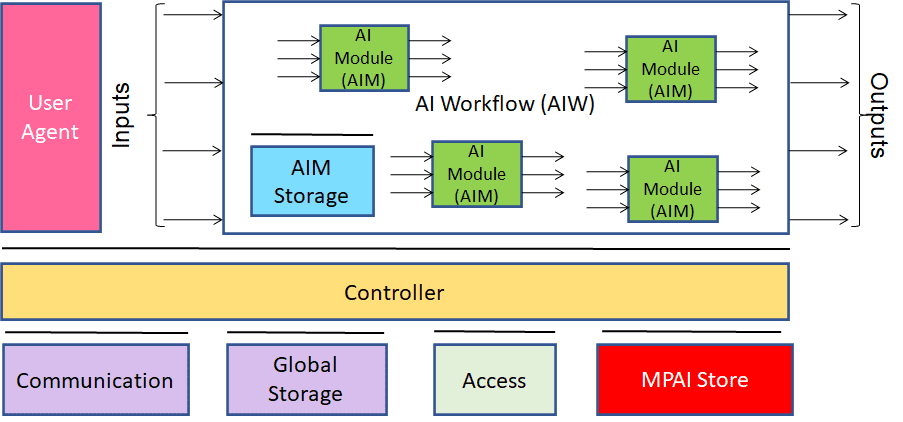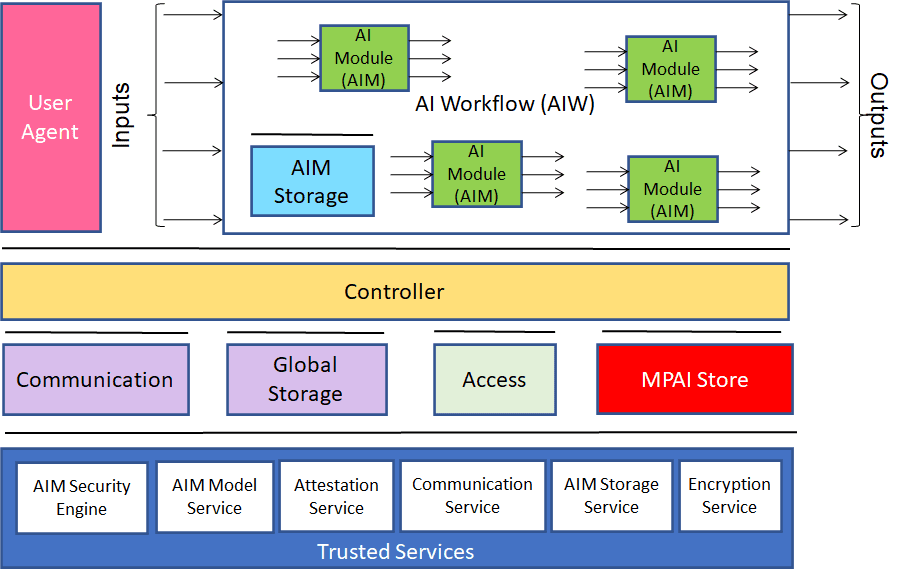
Moving Picture, Audio, and Data Coding by Artificial Intelligence (MPAI), an international unaffiliated not-for-profit organization, develops AI-based Data Coding standards with associated clear licensing frameworks.
Moving Picture, Audio, and Data Coding by Artificial Intelligence (MPAI), an international unaffiliated not-for-profit organisation, develops AI-based Data Coding standards with associated clear licensing frameworks.
It is costly to make complex AI applications because of the need for multidisciplinary competencies from data science to domain knowledge. Such “monolithic” AI applications are also obscure and often “unexplainable,” as it is hard to explain why a machine has produced a certain output.
MPAI launched the AI Framework (AIF) standard project in December 2020 to make it possible to execute AI Workflows (AIW) composed of AI Modules (AIM). Both AIWs and AIMs are defined by their function and their interfaces. Hence, the AIF is unconcerned by the technology used in an AIM but needs to know the topology of an AIW. AIF is specially designed for executing AI-based implementations but is also suitable for mixed AI and traditional data processing workflows (Figure 1).

Figure 1 – The MPAI-AIF Reference Model
The MPAI AI Framework standard (MPAI-AIF) specifies the architecture, interfaces, protocols, and a set of Application Programming Interfaces (API).
The AIF, the AIW, and the AIMs are represented by JSON Metadata. The User-Agent and the AIMs call the Controller through APIs. Likewise, the Controller calls Communication (a service for inter-AIM communication), Global Storage (a service for AIMs to store data accessible by other AIMs), and the MPAI Store (a service for downloading AIMs needed by an AIW). Access represents access to application-specific data.
Through the JSON Metadata, an AIF with appropriate resources (specified in the AIF JSON Metadata) can execute an AIW requiring AIMs (specified in the AIW JSON Metadata) that can be downloaded from the MPAI Store.
The MPAI-AIF standard achieves much of the original MPAI vision because AI applications need not be monolithic, are more explainable, and can be found in an open market of standard complying products.
As the AIF is required to be a Zero Trust Zone, but the standard does not offer an application developer the means use to ensure that the execution of the AIW takes place in a secure environment, MPAI has developed requirements for MPAI-AIF Version 2. It has identified specific trusted services meeting a set of functional requirements that enable AIF Components to access trusted services via APIs, as shown in Figure 2.

Figure 2 – Reference Models of MPAI-AIF V2
The following is the full set of requirements: AIF Components shall be able to call Trusted Services APIs after establishing a developer-specified security regime based on the following requirements:
- The AIF Components shall access high-level implementation-independent Trusted Services API to handle:
- Encryption Service.
- Attestation Service.
- Trusted Communication Service.
- Trusted AIM Storage Service including the following functionalities:
- AIM Storage Initialisation (secure and non-secure flash and RAM)
- AIM Storage Read/Write.
- AIM Storage release.
- Trusted AIM Model Services including the following functionalities:
- Secure and non-secure Machine Learning Model Storage.
- Machine Learning Model Update (i.e., full, or partial update of the weights of the Model).
- Machine Learning Model Validation (i.e., verification that the model is the one that is expected to be used and that the appropriate rights have been acquired).
- AIM Security Engine including the following functionalities:
- Machine Learning Model Encryption.
- Machine Learning Model Signature.
- Machine Learning Model Watermarking.
- The AIF Components shall be easily integrated with the above Services.
- The AIF Trusted Services shall be able to use hardware and OS security features already existing in the hardware and software of the environment in which the AIF is implemented.
- Application developers shall be able to select the application’s security either or both by:
- Level of security that includes a defined set of security features for each level, i.e., APIs are available to either select individual security services or to select one of the standard security levels available in the implementation.
- Developer-defined security, i.e., a combination of a developer-defined set of security features.
- The specification of the AIF V2 Metadata shall be an extension of the AIF V1 Metadata supporting security with either or both standardized levels and a developer-defined combination of security features.
- MPAI welcomes the submission of use cases and their respective threat models.
Below are a few useful links for those wishing to get additional information on the MPAI-AIF V2 Call for Technologies:
- The “About MPAI-AIF” web page provides some general information about MPAI-AIF.
- The 1’20” video (YouTube) and video (non-YouTube) give a concise illustration of the MPAI-MMC V2 Call for Technologies.
- The slides and the video registration of the online presentation (YouTube, non-YouTube) made at the online 11 July presentation give a complete overview of MPAI-AIF V2.
- The 3 documents Call for Technologies, Use Cases and Functional Requirements, and Framework Licence are a “must read” for those who intend to respond to the MPAI-AIF V2 Call for Technologies.
Responses to the Call for Technologies shall be received by the MPAI secretariat by 10 October 2022 at 23:39 UTC. For any need, contact the MPAI secretariat.
